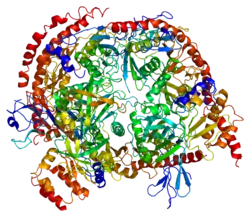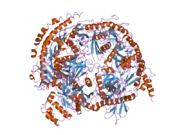Exosome component 5
Exosome component 5, also known as EXOSC5, is a human gene, which is part of the exosome complex.[5]
Biallelic pathogenic variation in EXOSC5 causes autosomal recessive cerebellar ataxia, brain abnormalities, and cardiac conduction defects (CABAC, MIM 619576).[6][7][8][9] Individuals with CABAC often have delayed developmental milestones, intellectual disability, cerebellar ataxia, hypotonia, dysarthria, and dysmorphic facies. Cardiac abnormalities including conduction defects, right bundle branch block, sinus node dysfunction, intraventricular conduction delay, atrioventricular block, and/or ventricular tachycardia. Cardiac pacemakers and defibrillators have been needed, and sudden cardiac death has been reported.[6][7][8][9]
Interactions
Exosome component 5 has been shown to interact with:
References
- GRCh38: Ensembl release 89: ENSG00000077348 - Ensembl, May 2017
- GRCm38: Ensembl release 89: ENSMUSG00000061286 - Ensembl, May 2017
- "Human PubMed Reference:". National Center for Biotechnology Information, U.S. National Library of Medicine.
- "Mouse PubMed Reference:". National Center for Biotechnology Information, U.S. National Library of Medicine.
- "Entrez Gene: EXOSC5 exosome component 5".
- "Entry - #619576 - CEREBELLAR ATAXIA, BRAIN ABNORMALITIES, AND CARDIAC CONDUCTION DEFECTS; CABAC - OMIM". omim.org. Retrieved 2023-01-23.
- Beheshtian M, Fattahi Z, Fadaee M, Vazehan R, Jamali P, Parsimehr E, et al. (June 2019). "Identification of disease-causing variants in the EXOSC gene family underlying autosomal recessive intellectual disability in Iranian families". Clinical Genetics. 95 (6): 718–725. doi:10.1111/cge.13549. PMID 30950035.
- Calame DG, Herman I, Fatih JM, Du H, Akay G, Jhangiani SN, et al. (August 2021). "Risk of sudden cardiac death in EXOSC5-related disease". American Journal of Medical Genetics. Part A. 185 (8): 2532–2540. doi:10.1002/ajmg.a.62352. PMC 8382094. PMID 34089229.
- Slavotinek A, Misceo D, Htun S, Mathisen L, Frengen E, Foreman M, et al. (August 2020). "Biallelic variants in the RNA exosome gene EXOSC5 are associated with developmental delays, short stature, cerebellar hypoplasia and motor weakness". Human Molecular Genetics. 29 (13): 2218–2239. doi:10.1093/hmg/ddaa108. PMC 7399534. PMID 32504085.
- Raijmakers R, Egberts WV, van Venrooij WJ, Pruijn GJ (November 2002). "Protein-protein interactions between human exosome components support the assembly of RNase PH-type subunits into a six-membered PNPase-like ring". Journal of Molecular Biology. 323 (4): 653–663. doi:10.1016/s0022-2836(02)00947-6. PMID 12419256.
- Raijmakers R, Noordman YE, van Venrooij WJ, Pruijn GJ (January 2002). "Protein-protein interactions of hCsl4p with other human exosome subunits". Journal of Molecular Biology. 315 (4): 809–818. doi:10.1006/jmbi.2001.5265. PMID 11812149.
Further reading
- Bonaldo MF, Lennon G, Soares MB (September 1996). "Normalization and subtraction: two approaches to facilitate gene discovery". Genome Research. 6 (9): 791–806. doi:10.1101/gr.6.9.791. PMID 8889548.
- Allmang C, Petfalski E, Podtelejnikov A, Mann M, Tollervey D, Mitchell P (August 1999). "The yeast exosome and human PM-Scl are related complexes of 3' --> 5' exonucleases". Genes & Development. 13 (16): 2148–2158. doi:10.1101/gad.13.16.2148. PMC 316947. PMID 10465791.
- Brouwer R, Allmang C, Raijmakers R, van Aarssen Y, Egberts WV, Petfalski E, et al. (March 2001). "Three novel components of the human exosome". The Journal of Biological Chemistry. 276 (9): 6177–6184. doi:10.1074/jbc.M007603200. PMID 11110791.
- Chen CY, Gherzi R, Ong SE, Chan EL, Raijmakers R, Pruijn GJ, et al. (November 2001). "AU binding proteins recruit the exosome to degrade ARE-containing mRNAs". Cell. 107 (4): 451–464. doi:10.1016/S0092-8674(01)00578-5. PMID 11719186. S2CID 14817671.
- Raijmakers R, Noordman YE, van Venrooij WJ, Pruijn GJ (January 2002). "Protein-protein interactions of hCsl4p with other human exosome subunits". Journal of Molecular Biology. 315 (4): 809–818. doi:10.1006/jmbi.2001.5265. PMID 11812149.
- Brouwer R, Vree Egberts WT, Hengstman GJ, Raijmakers R, van Engelen BG, Seelig HP, et al. (2002). "Autoantibodies directed to novel components of the PM/Scl complex, the human exosome". Arthritis Research. 4 (2): 134–138. doi:10.1186/ar389. PMC 83843. PMID 11879549.
- Yang XF, Wu CJ, Chen L, Alyea EP, Canning C, Kantoff P, et al. (October 2002). "CML28 is a broadly immunogenic antigen, which is overexpressed in tumor cells". Cancer Research. 62 (19): 5517–5522. PMC 4762257. PMID 12359762.
- Raijmakers R, Egberts WV, van Venrooij WJ, Pruijn GJ (November 2002). "Protein-protein interactions between human exosome components support the assembly of RNase PH-type subunits into a six-membered PNPase-like ring". Journal of Molecular Biology. 323 (4): 653–663. doi:10.1016/S0022-2836(02)00947-6. PMID 12419256.
- Lehner B, Sanderson CM (July 2004). "A protein interaction framework for human mRNA degradation". Genome Research. 14 (7): 1315–1323. doi:10.1101/gr.2122004. PMC 442147. PMID 15231747.
- Andersen JS, Lam YW, Leung AK, Ong SE, Lyon CE, Lamond AI, Mann M (January 2005). "Nucleolar proteome dynamics". Nature. 433 (7021): 77–83. Bibcode:2005Natur.433...77A. doi:10.1038/nature03207. PMID 15635413. S2CID 4344740.
- Rual JF, Venkatesan K, Hao T, Hirozane-Kishikawa T, Dricot A, Li N, et al. (October 2005). "Towards a proteome-scale map of the human protein-protein interaction network". Nature. 437 (7062): 1173–1178. Bibcode:2005Natur.437.1173R. doi:10.1038/nature04209. PMID 16189514. S2CID 4427026.
- Zhou H, Zhang D, Wang Y, Dai M, Zhang L, Liu W, et al. (August 2006). "Induction of CML28-specific cytotoxic T cell responses using co-transfected dendritic cells with CML28 DNA vaccine and SOCS1 small interfering RNA expression vector". Biochemical and Biophysical Research Communications. 347 (1): 200–207. doi:10.1016/j.bbrc.2006.06.093. PMID 16815301.
- Olsen JV, Blagoev B, Gnad F, Macek B, Kumar C, Mortensen P, Mann M (November 2006). "Global, in vivo, and site-specific phosphorylation dynamics in signaling networks". Cell. 127 (3): 635–648. doi:10.1016/j.cell.2006.09.026. PMID 17081983. S2CID 7827573.






